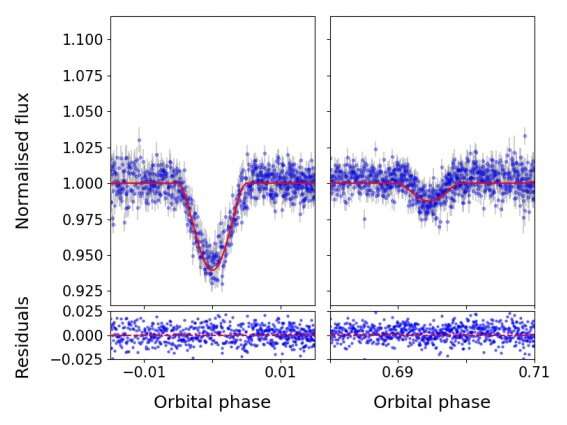NGTS photometry of the primary and secondary eclipses of NGTS J2143-38 folded on a period of 7.618 days. The red line shows the model fit obtained from joint modelling of photometric and spectroscopic data. Credit: Acton et al., 2020.
An international team of astronomers has discovered a new M-dwarf binary system as part of the Next Generation Transit Survey (NGTS). The newly found system, designated NGTS J214358.5-380102, turns out to be the most eccentric M-dwarf binary known to date. The finding is detailed in a paper published March 31 on arXiv.org.
M dwarfs, especially in eclipsing binaries, could be crucial for improving our understanding about fundamental stellar parameters of low-mass stars. In eclipsing binaries, the orbit plane of the two stars lies so nearly in the line of sight of the observer that the components undergo mutual eclipses. Such systems can provide direct measurement of the mass, radius and effective temperature of stars.
Located some 390 light years away from the Earth, NGTS J214358.5-380102 (NGTS J2143-38 for short) was initially detected in 2016 as a periodic source in NGTS photometric light curves. Follow-up photometric and spectroscopic observations of this source made by a group of astronomers led by Jack S. Acton of University of Leicester, U.K., have found that it is an eclipsing M-dwarf binary system.
"In this paper, we present the NGTS discovery of one such interesting M-dwarf binary, NGTS J214358.5-380102. We make use of follow-up photometry and radial velocity measurements to derive accurate orbital parameters for the system. We also use low resolution spectroscopy in order to accurately determine the spectral type of the system and allow for greater understanding of the context in which this discovery sits," the astronomers wrote in the paper.
According to the study, the NGTS J2143-38 system has an orbital period of around 7.62 days and consists of two roughly equal-sized stars of spectral type M3. The primary star has a radius of about 0.46 solar radii and a mass of some 0.42 solar masses, while the secondary star's radius and mass are approximately 0.41 and 0.45 than that of the sun, respectively.
The orbital eccentricity of NGTS J2143-38 was found to be 0.323, which is unusual for M-dwarf binaries, as such systems usually have almost circular orbits. Moreover, the estimated eccentricity makes NGTS J2143-38 the most eccentric M-dwarf binary known to date, and one of the most eccentric binaries of any type relative to its semi-major axis (approximately 15.62 solar radii).
The astronomers added that the high eccentricity and relatively short period of NGTS J2143-38 may suggest the presence of another object in the system. Future observations of the binary could be crucial in order to verify this scenario.
Summing up the results, the researchers note that the properties of NGTS J2143-38, especially its high eccentricity, make it an interesting target for further studies of binary star systems.
"As the most eccentric M-dwarf binary known, NGTS J214358.5-380102 provides an interesting insight into the strength of tidal effects in the circularization of stellar orbits," the authors of the paper concluded.
More information: NGTS J214358.5-380102—NGTS discovery of the most eccentric known M-Dwarf binary system, arXiv:2003.14314 [astro-ph.SR] arxiv.org/abs/2003.14314
© 2020 Science X Network
























